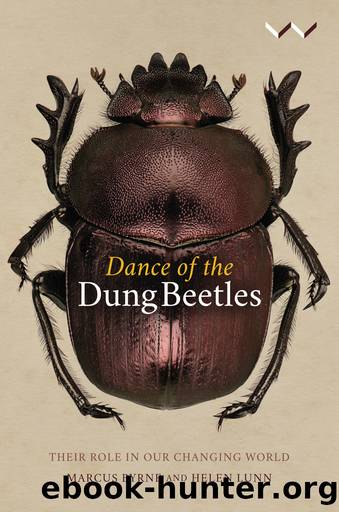Dance of the Dung Beetles by Marcus Byrne;Helen Lunn;

Author:Marcus Byrne;Helen Lunn;
Language: eng
Format: epub
Publisher: Wits University Press
Published: 2019-01-15T00:00:00+00:00
CHAPTER SIX
Tribes with human attributes
THE INCREASING SCIENTIFIC INTEREST in dung beetles was fuelled by both the burgeoning scientific industry (with biology diversifying into a multitude of new fields, from invasion biology to genetic engineering) and by the usefulness of dung beetles in our explorations of these new fields. Two characteristics of dung beetles have made them stars of the new biology: first, there are lots of them â over 6 000 species, offering a huge variety of already named species on which to test new ideas; secondly, they are incredibly compliant. Dung beetles, whether in captivity or the wild, get on with their lives regardless of who is watching or manipulating their small world. This makes them perfect subjects for studies of animal behaviour, in which we can ask questions of a simple animal and get straightforward answers, which in turn inform our understanding of how other organisms (including ourselves) perceive the world.
Why do animals move? For what purpose? The world is full of animals with which we share common spaces. Most of those animals move, apparently with reason or purpose, leading us to wonder what they are up to. These questions are at the core of the study of animal behaviour which, despite being an ancient human activity, is considered to be a relatively young science. Nevertheless, being formalised as a science under the rubric of âethologyâ by French biologist Isidore Geoffroy Saint-Hilaire (1805â1861) gave credibility to the careful observation of nature often provided by enthusiastic collectors. Darwin treated behaviour (along with structure) as a characteristic subject to natural selection, which could therefore influence an organismâs chance of survival and reproduction. Unfortunately, Saint-Hilaire chose a word deriving from âethosâ (from the Greek for âmoral characterâ) and with a history of other meanings. Seventeenth century actors who portrayed human characters on stage were known as ethologists, while John Stuart Mill used the word ethologists to describe those who studied ethics. The name ethology has nevertheless stuck, and is used to describe the study of the behaviour of animals in their natural habitat.
Fabre (despite his rejection of a Darwinian interpretation of why the natural world looked the way it did) made important contributions to the infant science of ethology through his detailed observations of the behaviour of dung beetles and other insects, including bees and wasps. The first obviously ethological publications were studies of bird behaviour, published in 1911 and 1919. Because birds are easily seen and have stereotypical behaviours, it is not surprising that they were the main subject of study for Konrad Lorenz and Nikolaas Tinbergen, who worked in Europe in the 1920s and 30s. Nevertheless, the man with whom they shared the Nobel Prize in 1973 worked on bees. Karl von Frisch (1886â1982) devoted his life to the study of their behaviour âthus discovering a true language of gestures for communication and opening new insights into the knowledge of insect behaviour.â1 It is worth noting that this joint Nobel Prize was awarded for Physiology and Medicine (there is
Download
This site does not store any files on its server. We only index and link to content provided by other sites. Please contact the content providers to delete copyright contents if any and email us, we'll remove relevant links or contents immediately.
| Cell Biology | Developmental Biology |
| Entomology | Marine Biology |
| Microbiology | Molecular Biology |
| Biostatistics |
Sapiens: A Brief History of Humankind by Yuval Noah Harari(13962)
The Tidewater Tales by John Barth(12384)
Mastermind: How to Think Like Sherlock Holmes by Maria Konnikova(6918)
Do No Harm Stories of Life, Death and Brain Surgery by Henry Marsh(6675)
The Thirst by Nesbo Jo(6425)
Why We Sleep: Unlocking the Power of Sleep and Dreams by Matthew Walker(6331)
Life 3.0: Being Human in the Age of Artificial Intelligence by Tegmark Max(5169)
Sapiens by Yuval Noah Harari(5111)
The Longevity Diet by Valter Longo(4850)
The Body: A Guide for Occupants by Bill Bryson(4566)
The Rules Do Not Apply by Ariel Levy(4508)
The Immortal Life of Henrietta Lacks by Rebecca Skloot(4239)
Why We Sleep by Matthew Walker(4188)
Animal Frequency by Melissa Alvarez(4143)
Yoga Anatomy by Kaminoff Leslie(4097)
The Hacking of the American Mind by Robert H. Lustig(4071)
All Creatures Great and Small by James Herriot(3972)
Barron's AP Biology by Goldberg M.S. Deborah T(3938)
Double Down (Diary of a Wimpy Kid Book 11) by Jeff Kinney(3909)
